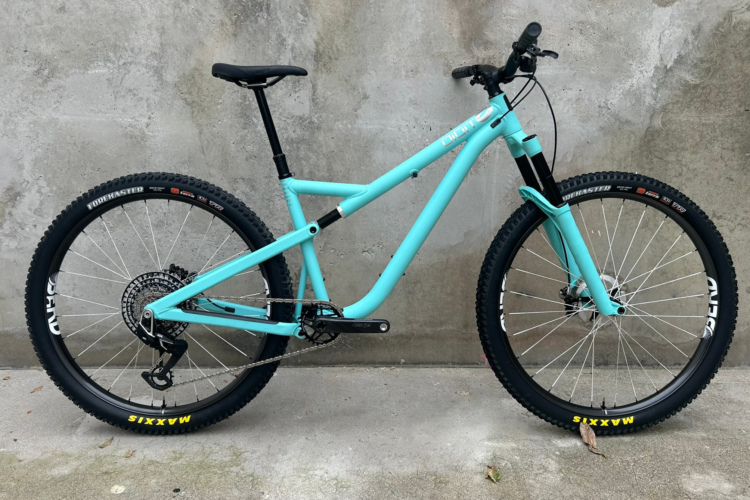
When Maxxis announced offerings of some of their current treads in 2.6″, I was like whaaa?! I was excited. Earlier this year, the 2.6″ Maxxis Forekaster won me over for its proficient, playful, and predictable mannerisms. In fact, the Forekaster is going right back on (as a rear) for the summer. Needless to say, I was more than interested in putting the Rekon of the same 2.6″ width to the test.
Bottom Line: Although billed by Maxxis as an “aggressive trail” tire, the Rekon is more fit for the XC crowd looking for a slight advantage over the Ikon – an XC thoroughbred. The larger 2.6″ footprint enhances traction while rewarding speed in the right terrain. 2.6 may also present somewhat of a solution to those with plus-size envy or if you’re looking to put your current plus bike on a diet.
Specifications
Maxxis offers two Rekon constructions in the 2.6″. Here, I review the 3C Maxx Terra compound with EXO sidewall protection and 120 TPI casing (730g). Maxxis’ Triple Compound (3C) employs a hard, long-lasting base with two softer outer layers. Maxx Terra sits between the harder Maxx Speed and the softest Maxx Grip. The lower spec Rekon also comes with EXO sidewalls, but uses a dual compound with 60 TPI (800g). Both specs are tubeless-ready and have a folding Kevlar bead. As of this review, the Rekon 2.6 is only available to 27.5″ wheel users. MSRP for the 3C Maxx Terra and Dual Compound version is $85 and $80, respectively.
Inspired by the Ikon, the Rekon aims for more aggressive trail, but maintains a low profile tread. Center knobs alternate between a wide and wider profile to provide control under braking, and each are ramped to decrease rolling resistance. Transition knobs zigzag, creating an overall pattern that is evenly spread and void of any channeling. L-shaped lugs line the shoulders of the Rekon and have proven on other models to be very supportive through turns. From center to shoulder, every knob features some degree of siping for a better bite.
Mounting
I mounted a pair of Rekon 2.6 3C/EXO Maxx Terra tires to a set of 27.5″ DT Swiss EX 511 alloy rims measuring 30mm internally. The tubeless-ready Kevlar bead seated up easily with no more than a floor pump and 3oz of Orange Seal. Aired to 40psi, the Rekon has a round profile and, despite the 2.6″ label, measured 62mm (2.4″) sidewall to sidewall. This initial off-measurement is no different than many Maxxis tires, which are often over estimated. Maxxis recommends leaving the tire inflated to max psi for 24-48 hours, allowing it to stretch to the specified width. Mounted, there was plenty of room to spare within my non-Boost chainstays and RockShox Pike.
[see_also id=”196313″][/see_also]
Riding the Rekon
Disclaimer: I wouldn’t typically consider the Rekon as my go-to rubber for what I ride. Only a small portion of my riding can be categorized as XC, I only climb to descend, and I never let the sun set on a shuttle. At the risk of annoying some readers, I didn’t change my riding to fit the Rekon, but rather rode the tire in the same terrain that calls for a much heavier casing and meatier knobs. That said, I consider my downhill/enduro-ish lean would provide a unique perspective on a tire that was designed for anything but.
First off, the Rekon is fast! And by fast, I mean quick to accelerate with an aptitude for sustaining every unit of momentum you can muster. These two characteristics are thanks to a low profile, evenly-spread tread, and light, 120 TPI casing. Provided the trail wasn’t too loose, climbing was made easy and there was just enough tread for that get-up-and-go sprint.
The small tread matched with a 2.6″ footprint took mild drops and trailside kickers with little fuss, but I wouldn’t exactly call it confidence-inspiring. Like a great XC tire, the Rekon enjoys as much contact with the ground as possible, rewarding speed and agility to those that abide.
Of course, a fast tire also depends on adequate traction during acceleration, braking, and cornering which, for the Rekon, was highly dependent on terrain and conditions. The Rekon seems most at home on hard pack, while loose and loose over hard often resulted in an early, albeit predictable, break in traction. The smaller tread was often overwhelmed when crawling over slippery rock and root despite extensive siping. Mounted to an appropriately-wide 30mm internal rim, I didn’t hesitate dialing pressures to 18-20psi, resulting in zero squirm and slightly better traction, yet not enough to justify the Rekon on what I would consider “aggressive” trail.
Plus/Minus: Another New Standard
Okay, so you’re not racing downhill on the Maxxis Rekon… The real story here is a familiar tread that, until now, was only offered in a 2.8″ width for plus bikes. The move to 2.6″ is both obvious yet interesting. Obvious because we had 2.3-2.5″ in select treads for a while before jumping to 2.8-3.0″ with Boost-spaced bikes. It seemed only a matter of time before the tire industry would bridge the gap. Interesting because many 27.5+ bike owners may have found themselves in the following predicament: 3.0″ wheels squirm like the dickens, and/or not everyone can justify a set of 29er wheels to lighten up the load. Thus, depending on bottom bracket height, 27.5Plus-ers may fancy a narrower tire in the same diameter for a more nimble ride. On the other hand, 30-ish millimeter rims are becoming a new norm (regardless of rear axle spacing), and tires must grow in parallel.
This 2.6 Plus/Minus size has become a sub-category, if you will, of plus tires: plus enough to appropriately engage a 30-35mm wide rim, but not so plus you need Boost spacing. With 2.6, you don’t have to get a new bike, just new tires!
Thanks to Maxxis for providing the Rekon 2.6 for review!
























